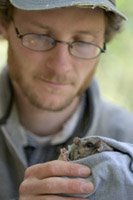LOOKING
FOR WILDLIFE BIOLOGY EXPERIENCE?
The Greater Fundy Ecosystem Research Group (University of New Brunswick) is hiring 1 crew leader and 4 field technician positions to work from June until Nov /2008 (shorter time periods may be possible) in Fundy National Park, New Brunswick on a northern flying squirrel (Glaucomys sabrinus) research project. Work will consist of running live-trapping grids, radio-tracking of collared flying squirrels and nest-box monitoring.
Applicants should:
Be physically fit.
Have a strong interest in ecology and conservation.
Have a valid driver’s license.
Be responsible, hard working, and enjoy working in the great outdoors.
Applicants should have knowledge/experience in:
Fieldwork and data collection.
Establishing sampling grids (GPS and compass skills)
Basic plant identification (mushroom id an asset)
Radio-telemetry (an asset)
Mammology (an asset)
Mark-Recapture techniques (an asset)
Pay is $1,200/month for field technicians, $1,400/month for crew leader (room and board is covered by the project). Send resume by email/or for more information contact: Matthew Smith at matthew.smith@unb.ca
Deadline for Application: April 11/08
Thursday, March 13, 2008
Almost one year later?
Wow..time flies. I am not so good at updating this Blog site. But I will aim to improve things this field season. Last year was a success with many flying squirrels captured on our grids and lots of night tracking sesssions! The night tracking sessions were the most interesting work that we have done so far. Instead of using triangulations to estimate the locations of flying squirrels (which is prone to error) we decided to track squirrels by following them in the forest and use head lamps to observe their behaviour. We were able to get quite close to many of the squirrels and observed them eating tuffles, mushrooms, buds, and fir cones. In many cases the flying squirrels seem quite undisturbed by our presense and went on doing their thing. The only difficult part was when they took off quickly and we were left in their dust. As expect males had the largest home ranges with some of the home ranges over 20 hectares in size. One little guy moved over a kilometer in a half between two mature forest patches. I suspect that he was born at one of the sites and was trying to decide where to settle down.
Here is a picture of one squirrel eating a cone a night. Here name is Fanny. You can see the radio collar underneath her neck. Mike Avery took this picture.
Here is a picture of one squirrel eating a cone a night. Here name is Fanny. You can see the radio collar underneath her neck. Mike Avery took this picture.
Subscribe to:
Posts (Atom)

